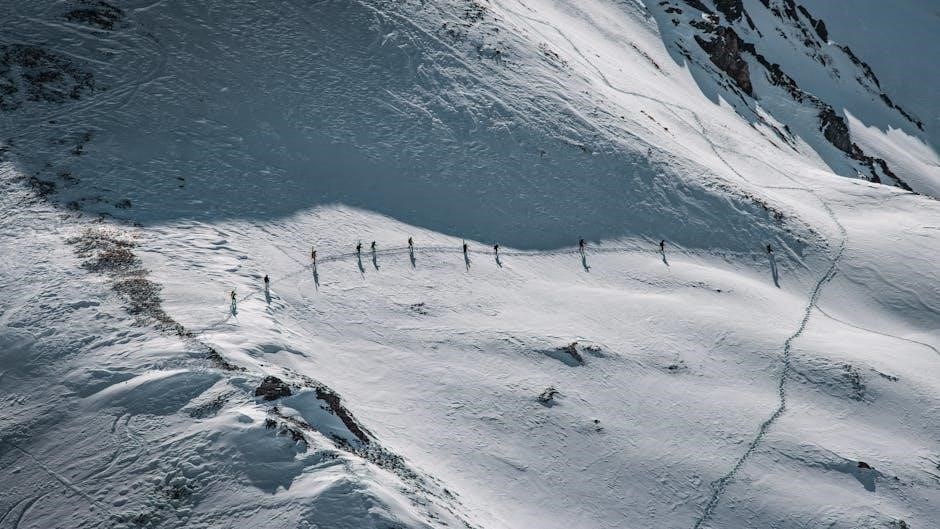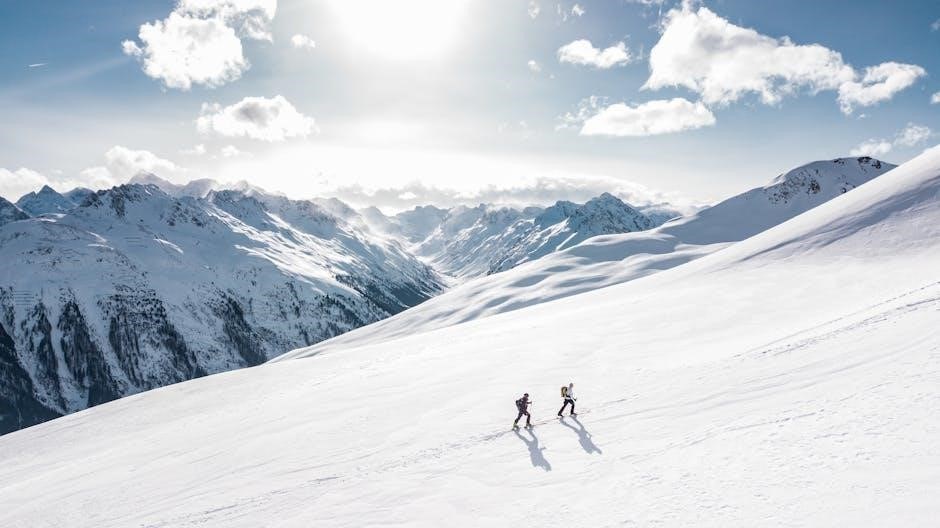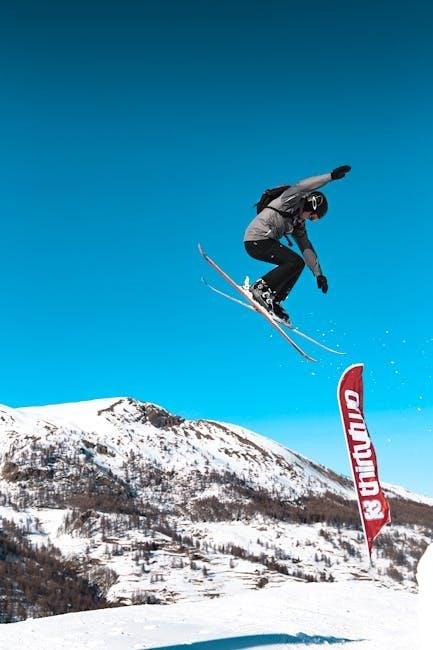Choosing the right ski size is essential for optimal performance, control, and enjoyment on the slopes․ Ski length depends on height, weight, skill level, and terrain type, ensuring proper fit for all skiers․
What is a Ski Size Guide?
A ski size guide is a tool or resource that helps determine the appropriate ski length and width for a skier based on their height, weight, skill level, and terrain preferences․ It typically includes charts or formulas to recommend the best fit for different types of skis, such as all-mountain, powder, or slalom skis․ The guide ensures that skiers can enjoy optimal performance, control, and comfort on the slopes by selecting skis that match their needs and abilities․
Why is Choosing the Right Ski Size Important?
Choosing the right ski size is crucial for optimal performance, control, and comfort on the slopes․ Skis that are too long or too short can hinder maneuverability and stability, making it harder to balance and control your movements․ Properly sized skis ensure better balance, effortless turning, and enhanced enjoyment of the skiing experience․ Incorrect sizing can lead to fatigue and difficulty in navigating various terrains, making it essential to select skis that align with your height, weight, skill level, and skiing style for the best results․

Key Factors Influencing Ski Size
The key factors influencing ski size include the skier’s height, weight, skill level, and terrain type․ These elements ensure the skis are proportionate and suitable for optimal performance․
Skier’s Height
A skier’s height is a fundamental factor in determining ski length․ Generally, ski length is proportional to the skier’s height, with specific guidelines for different skill levels․ For beginners, skis typically reach the chin when stood upright, while intermediate skiers may opt for slightly longer skis․ Advanced skiers often prefer skis closer to their height for better control․ Height helps establish a baseline, ensuring the skis are easy to maneuver and provide the right balance of stability and responsiveness on the slopes․ Properly sized skis based on height enhance overall performance and enjoyment․
Skier’s Weight
A skier’s weight plays a crucial role in determining the appropriate ski size․ Lighter skiers may prefer shorter skis for easier maneuverability, while heavier skiers often benefit from longer skis for added stability․ Weight affects how the skis interact with the snow, influencing floatation and control․ Properly balancing weight with ski length ensures optimal performance, preventing the skis from feeling too cumbersome or too fragile․ When combined with height and skill level, weight helps refine the ideal ski size for a personalized fit and enhanced skiing experience․
Skier’s Skill Level
A skier’s skill level significantly impacts the ideal ski size․ Beginners benefit from shorter skis, which are easier to control and maneuver․ Intermediate skiers often prefer mid-length skis for stability and versatility․ Advanced skiers may opt for longer skis to maximize speed and performance․ Skill level influences how effectively a skier can manage the ski’s length, with more experienced skiers handling longer skis with ease․ Balancing skill level with height and weight ensures the skis respond well to the skier’s movements, enhancing the overall skiing experience and progression․
Type of Terrain
The type of terrain you ski on plays a crucial role in determining the ideal ski size․ For example, powder skis are longer and wider to float in deep snow, while slalom skis are shorter for agility on groomed trails․ All-mountain skis offer versatility for various conditions, balancing length and width․ Terrain-specific skis are designed to optimize performance, whether carving on hardpack or navigating backcountry․ Choosing the right size ensures the skis handle the terrain effectively, enhancing both control and enjoyment․ Matching ski size to terrain type is essential for a tailored skiing experience․

Ski Size Charts and Recommendations
Ski size charts provide a framework to determine the ideal ski length based on height, weight, and skill level․ These charts offer standardized guidelines to help skiers choose skis that suit their needs, ensuring optimal performance and comfort․ By referencing these charts, skiers can narrow down their options and make informed decisions tailored to their skiing style and preferences․ Adhering to these recommendations enhances the overall skiing experience․
How to Use Ski Size Charts
To use ski size charts effectively, start by identifying your height, weight, and skill level․ Align these factors with the chart’s recommendations to find your ideal ski length range․ Consider the type of terrain you’ll be skiing on, as this can influence the suggested length․ Adjustments may be needed based on personal preference, with shorter skis offering easier maneuverability and longer skis providing stability at higher speeds․ By following these steps, you can select skis that match your needs and enhance your skiing experience․
Standard Ski Length Recommendations
Standard ski length recommendations typically range from 140cm to 190cm, varying based on skier height, weight, and ability; Beginners often prefer skis reaching their chin, while intermediate skiers opt for lengths up to their nose․ Advanced skiers may choose longer skis, up to forehead height, for better stability at higher speeds․ These guidelines help skiers find a balanced length for control, maneuverability, and performance, ensuring an enjoyable experience on the slopes regardless of skill level or terrain․

How to Determine Your Ski Size
Determining your ski size involves considering height, weight, skill level, and terrain preferences․ Use size charts and adjust based on personal skiing style for optimal performance and comfort․
Calculating Ski Length Based on Height
Calculating ski length based on height is a common starting point․ For beginners, subtract 20cm from your height, while intermediate skiers subtract 10cm․ Advanced skiers may opt for full height or slightly more․ This method provides a baseline, but adjustments are made for weight, ability, and terrain․ For example, lighter skiers might prefer shorter skis, while heavier skiers may need longer ones for stability․ Always measure height without shoes for accuracy․ This calculation ensures a balanced fit, enhancing control and performance on the slopes․
Adjusting for Weight and Ability
Weight and ability significantly influence ski size adjustments․ Lighter skiers may prefer shorter skis for easier control, while heavier skiers often need longer skis for stability․ Skill level also plays a role: beginners benefit from shorter skis for maneuverability, intermediates find a balanced length ideal, and advanced skiers can handle longer skis for speed and performance․ Adjusting based on these factors ensures optimal control and confidence on the slopes, tailored to individual needs and skiing style․

Types of Skis and Their Size Considerations
Different ski types—like all-mountain, powder, slalom, and freestyle—require specific size considerations․ Each type is designed for unique performance needs, ensuring the right fit for every skier․
All-Mountain Skis
All-mountain skis are designed for versatility, catering to skiers who explore various terrains․ They balance performance on groomed trails and off-piste conditions․ When choosing a size, consider your height, weight, and skill level․ Generally, all-mountain skis range from 160cm to 190cm, with waist widths between 80-100mm for better float in powder and stability on hard snow․ Lighter skiers may prefer shorter lengths, while heavier skiers opt for longer skis․ Proper fit ensures optimal control and maneuverability across diverse skiing environments․
Powder Skis
Powder skis are designed for deep snow and off-piste adventures, offering superb float and maneuverability․ They typically feature wider waist widths (110mm+) and rocker profiles for easy turning․ Skiers should choose lengths ranging from 180cm to 200cm, depending on height, weight, and ability․ Lighter skiers may prefer shorter lengths for agility, while heavier skiers benefit from longer skis for stability․ Proper sizing ensures optimal performance in deep snow and varied terrain, making powder skis ideal for those seeking thrilling backcountry experiences․
Slalom Skis
Slalom skis are designed for precision and agility, ideal for racing and groomed terrain․ They are shorter and narrower than all-mountain skis, with lengths ranging from 150cm to 170cm․ Their shorter turning radius allows quick, sharp turns, making them perfect for skilled skiers․ Skiers should choose sizes based on height, weight, and ability, with lighter skiers preferring shorter lengths for better control․ Proper sizing ensures enhanced maneuverability and performance in slalom courses or tight, technical runs, catering to intermediate to advanced skiers seeking precision and speed․
Freestyle Skis
Freestyle skis are designed for versatility and creativity in parks and urban environments․ They are shorter and more flexible, with a symmetrical shape, allowing for easy maneuverability and switch riding․ Sizes typically range from 150cm to 190cm, depending on the skier’s height and weight․ Lightweight skiers may prefer shorter lengths for better control, while heavier skiers benefit from longer skis for stability․ Proper sizing ensures optimal performance in tricks, jumps, and rails, making freestyle skis ideal for those who enjoy experimenting with new techniques and exploring diverse terrain․

Choosing the Right Ski Size for Your Needs
Selecting the ideal ski size involves balancing height, weight, skill level, and terrain preferences․ Proper sizing enhances performance, control, and comfort, ensuring an optimal skiing experience for all․
Prefer Longer Skis or Shorter Skis?
Choosing between longer or shorter skis depends on your skiing style and preferences․ Longer skis provide stability at high speeds and better float in deep snow, making them ideal for experienced skiers and powder enthusiasts․ Shorter skis, on the other hand, are more maneuverable and easier to handle, which is beneficial for beginners or those who prioritize agility and quick turns․Terrain type also plays a role; shorter skis excel in tight spaces like trees or slalom courses, while longer skis perform best in open terrain and groomed trails․ Ultimately, the decision depends on balancing your skill level, skiing goals, and the type of skiing you’ll be doing most often․ Proper fit ensures optimal performance and enjoyment on the slopes․
Considering Waist Width and Shape
Waist width and ski shape significantly impact performance․ Narrower skis excel on groomed trails, offering precision and edge hold, while wider skis provide better float in powder․ All-mountain skis often feature a medium waist width for versatility․ Shape, such as directional or twin-tip designs, also matters․ Twin-tip skis are ideal for freestyle, while directional shapes enhance stability at speed․ Matching waist width and shape to your skiing style ensures optimal performance․ Proper fit guarantees comfort and control, making your skiing experience more enjoyable and effective․ Waist width and shape should align with your skill level and terrain preferences for the best results․

Importance of Proper Ski Fit
Proper ski fit enhances performance, control, and balance, ensuring maximum efficiency on the slopes․ A well-fitted ski boosts confidence and overall skiing experience․
How Proper Fit Affects Performance
A well-fitted ski significantly enhances performance by improving control, balance, and maneuverability․ Properly sized skis allow for precise turning and responsiveness, making skiing more efficient and enjoyable․ They also reduce fatigue, as less effort is required to manage the skis․ Conversely, skis that are too long or too short can hinder performance, making it harder to control movements and maintain stability․ Ensuring the right fit is crucial for maximizing skiing potential and enjoying a smooth, confident experience on the slopes․
Common Mistakes in Ski Sizing
One common mistake is ignoring height, weight, and skill level when selecting ski size․ Many skiers choose skis too long or too short based on trends rather than personal needs․ Another error is not considering terrain type, leading to poor performance in specific conditions․ Additionally, some skiers overlook waist width and shape, which are critical for stability and maneuverability․ To avoid these mistakes, it’s essential to consult a size chart and seek expert advice to ensure the best fit for optimal skiing performance and control․
Selecting the right ski size ensures a better skiing experience․ Consider height, weight, ability, and terrain for optimal performance and control on the slopes․
Final Tips for Selecting the Right Ski Size
When choosing your ski size, remember that proper fit enhances performance and control․ Consider your height, weight, skill level, and terrain preferences․ For beginners, shorter skis are easier to maneuver, while longer skis suit advanced skiers for stability․ Adjustments may be needed based on body type and skiing style․ Always refer to size charts and seek professional advice if unsure․ The right ski size ensures a safer and more enjoyable experience on the slopes․
